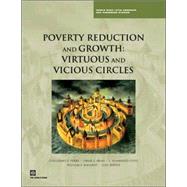Poverty Reduction and Growth Virtuous and Vicious Circles
, by Perry, Guillermo E.; Serven, Luis; Maloney, William F.; Lopez, J. Humberto; Arias, Omar- ISBN: 9780821365113 | 0821365118
- Cover: Paperback
- Copyright: 2/20/2006
Though growth is key for poverty reduction, poverty itself is hampering the achievement of high and sustained growth rates in Latin America, which remains one of the most unequal regions in the world with close to a fourth of the population living on less than US$2.00 a day. While China experienced annual per capita growth of about 8.5 percent between 1981 and 2000, reducing poverty by 42 percentage points, Latin America's per capita GDP declined by 0.7 percent during the 1980s and increased by about 1.5 percent per year in the 1990s, with no significant changes in poverty levels. The study notes that a pro-growth-poverty reduction strategy should aim to improve the quality of education, expand coverage at secondary and tertiary levels, and boost investment in infrastructure to benefit laggard regions and increase the access of the poor to public services. In addition, such a strategy needs to extend access to credit and financial services, preserve macro-economic stability, and implement effective social policies, such as conditional cash-transfer programs that provide cash to poor families as long as they keep their children in school and take them to the doctor. Some examples are Bolsa Familia in Brazil, Oportunidades in Mexico, and Familias en Accion in Colombia. The report notes that targeted poverty reduction strategies are particularly important to complement pro-growth policies like trade liberalization, which although essential for long-term growth and poverty reduction, can also have short-term negative effects on poverty and inequality






